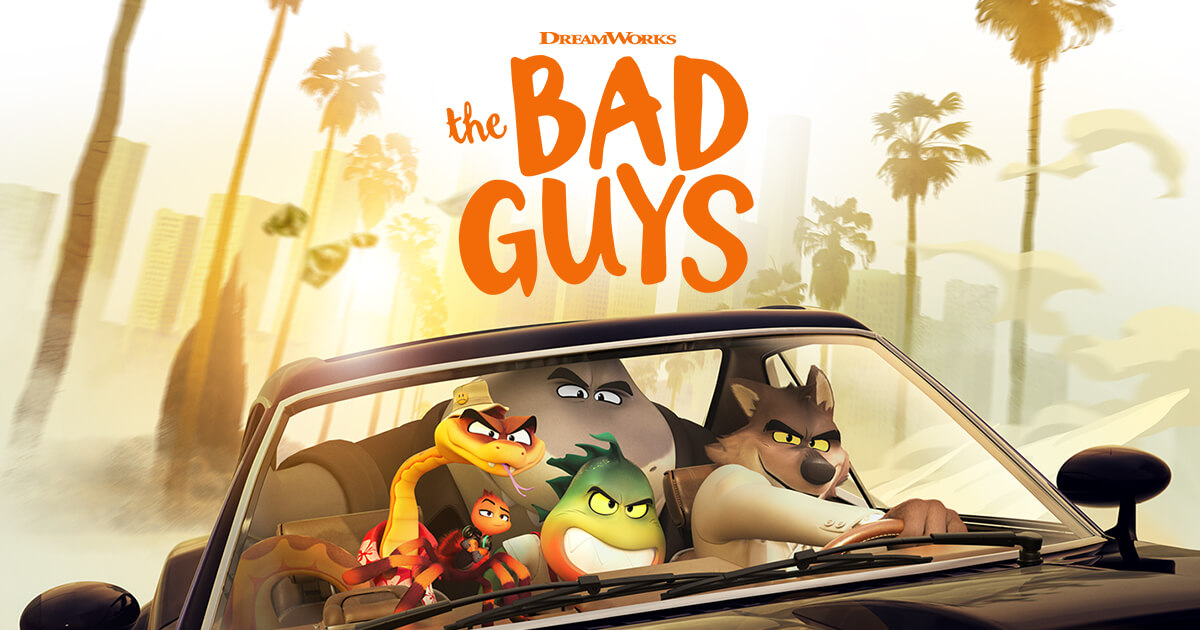Being good is no fun at all — or is it? Pierre Perifel’s feature directorial debut, tells the story of an infamous criminal group comprised of anthropomorphic animals — the titular Bad Guys — and how their leader begins to realise how good it feels to be…good? Following a parallel plot to Disney’s Zootopia (2016), The Bad Guys shows that even the most misunderstood members of society can change their ways and break through harmful stereotypes. In a world where anthropomorphic animals and humans co-exist, our protagonist Wolf admits how difficult it is to live as a wolf since he is always ‘the bad guy’ in every story, so why should he try to change? The story follows his progression from a cocky, cool headed criminal to the ‘good guy’ when another villain begins to hatch his own plans. The film uses animal characters as an allegory for self improvement, to create a relatable moral which will resonate with children and adults alike. This article will focus on some key themes in the film, including human/animal relations, how the character Diane adapts to the human centric world, and the ways in which the film makes us more trusting of certain animals over others.
Film Synopsis
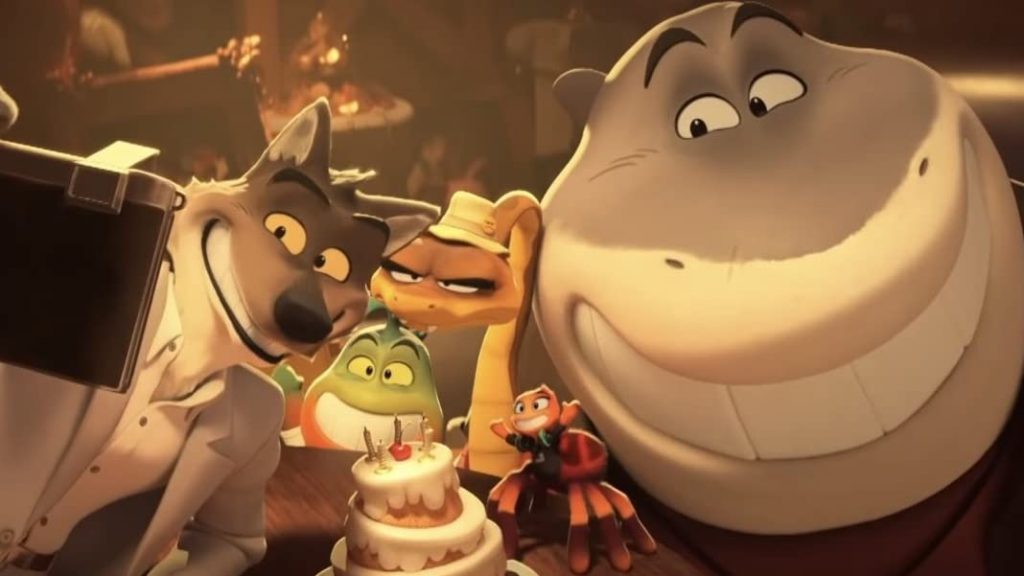
The film opens with an unbroken shot in which Wolf and Snake, the leader’s best friend and second-in-command, are having a meal in a diner, à la Pulp Fiction. When Wolf goes to pay for the meal, the human characters begin screaming and cowering in the corner of the diner – establishing their reputation in society immediately. After a lifetime of committing the most legendary heists, The Bad Guys are are goaded into staging another, more spectacular robbery by the anthropomorphic fox Diane Foxington, an anthropomorphic fox. However, due to a certain encounter in which Wolf accidentally helps an old lady, they must work to pull off their greatest con yet – becoming upstanding members of society. Under the tutelage of the adorable and kind hearted guinea pig Professor Marmalade, The Bad Guys must fool the humans that they have changed for the better, all while planning their grandest heist yet.
Human and Animal Relations in The Bad Guys
In The Bad Guys, the human characters are mainly used to set the stigma to which the gang are victims to. Only Chief Luggins, a brutish policewoman, is given a side role to the main anthropomorphic characters. However, the humans do serve a role in the story – to show how frightening The Bad Guys are in this world. In this scene, it only takes Snake and Wolf walking down the street to send people into a frenzy. The main characters stroll casually into a bank, and Wolf announces, “Don’t mind us, just robbing this place!”, and the background humans immediately run away. Their appearance alone is frightening enough for the humans, and the crime duo don’t even require weaponry or threats to pull off their heists. Wolf then addresses the viewer directly, in which he gives a meta-textual monologue, “You’re afraid, because I’m the…big bad wolf. I’m not surprised, I am the villain in every story.”
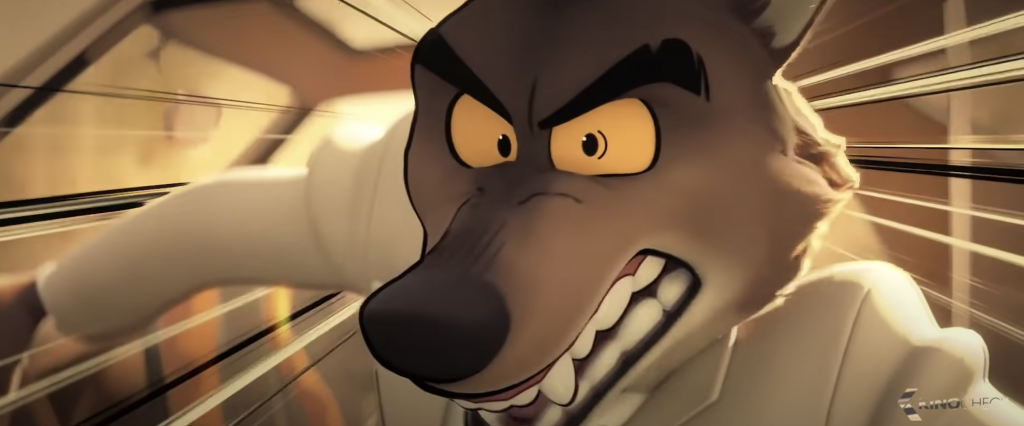
Wolf’s entire head takes up the majority of this shot, as he bears his teeth to the viewer. The art style changes too, with bold lines surrounding his wide eyes and teeth, emphasising what is commonly associated to be frightening in wolves. The motion lines around his face are synonymous with comic books, leaning into the idea that his characterisation is based on fictional stories. However, unlike what the humans of this world believe, the scene goes on to reveal Wolf isn’t all that scary; he celebrates his friend’s birthday, and has banter with his gang. This aids in allowing the viewer to relate to Wolf’s character, as fictional anthropomorphic characters require ‘human’ traits to be relatable, and this allows us to view Wolf as a ‘good guy’ who does bad things.
Wolf draws upon classical fairy tales such as Little Red Riding Hood and The Three Little Pigs, claiming the humans in this world view his bad behaviour as natural and expected of a wolf. The film plays on the idea of a dichotomy between the wild and naturalistic animals and the civilised, ordered humans. However, Wolf’s ‘animalistic’ side is rarely explored in the film, and his portrayal as a ‘bad guy’ is one, in his own words, based on fairy tales and myth. This can be expected from the humans in this universe, as they are not portrayed as particularly intelligent; in this scene for instance, the police are constantly overwhelmed by simple tricks, despite the size of their force.
Unlike in similar anthropomorphic films such as Zootopia or Madagascar, animalising is inconsistent in The Bad Guys; Snake, for example, uses traits expected of snakes, from fictional characterisations such as being sneaky and duplicitous, to literal factors such as his long, slim body. In contrast, Shark is presented very much separate from the animal on which he is based upon, being bipedal and many of his talents within the gang being almost entirely irrelevant to these stereotypes or characterisations (most obviously, he is a shark out of water). Snake himself tries to keep up the appearance of a malicious character throughout the film, which is in line with his beliefs about how The Bad Guys are condemned to their prejudices. This results in Snake being portrayed as the creator of tension amongst the group, which is foreshadowed in the film’s opening sequences, as he tends to act skittish and crude towards his friends. However, the film shows that even Snake does have a kind side, as this façade is due to him wanting to protect his friends from how human society views them.
The tension in the film comes from however the humans choose to feel about the gang, which changes on a whim. The Bad Guys themselves are aware of the stigma they face from being ‘scary’ animals, and is the reason why they commit crimes in the first place — it is what the humans expect from them. Wolf admits, “These are the cards we’ve been dealt, so we might as well play them.” The reason the group stick together is because of this ostracisation from society, and they simply accept their fate until Wolf begins to realise that he wants to change his ways.
Why Diane left the Crimson Paw Behind
Diane’s character in The Bad Guys is used as foil for Wolf. Up until her reveal as the infamous thief, The Crimson Paw, Diane is presented as a noble governor, respected by the human characters. Excluding Professor Marmalade, Diane is the only anthropomorphic character to gain the admiration of the humans, and this scene reveals how she changed to receive approval.
Diane recognises her abilities, “I was fast, fearless, inventive”; contrasting these traits to how the human characters act, it can be implied these characteristics are due to her being a fox. She reflects on her identity as a fox when stealing the Golden Dolphin in a similar fashion to Mr Fox in Fantastic Mr Fox. In the latter film, Mr Fox wonders how a fox can be happy without ‘engaging in foxlike activities’, understanding that ‘foxes traditionally like to court danger, hunt prey, and outsmart predators.’ Diane’s revelation is slightly more simplistic than Mr Fox’s as she realises that stealing the Golden Dolphin would cement the idea that she is a ‘tricky fox’, and in that moment, decided the risk was not worth it. Similar to Mr Fox, she knows the stereotypes humans have about foxes, and recognises her own desire to ‘court danger’ and ‘outsmart predators’. However, the film does not treat this as an instinctual desire of foxes, as Diane easily adapts to living as a regular, upstanding member of society, without needing to give into any impulses brought on by her species.
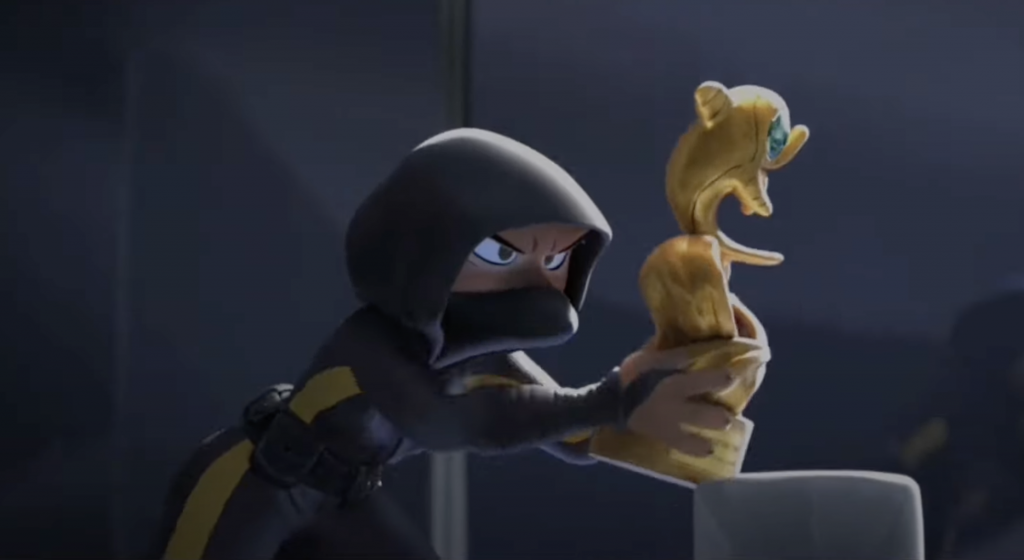
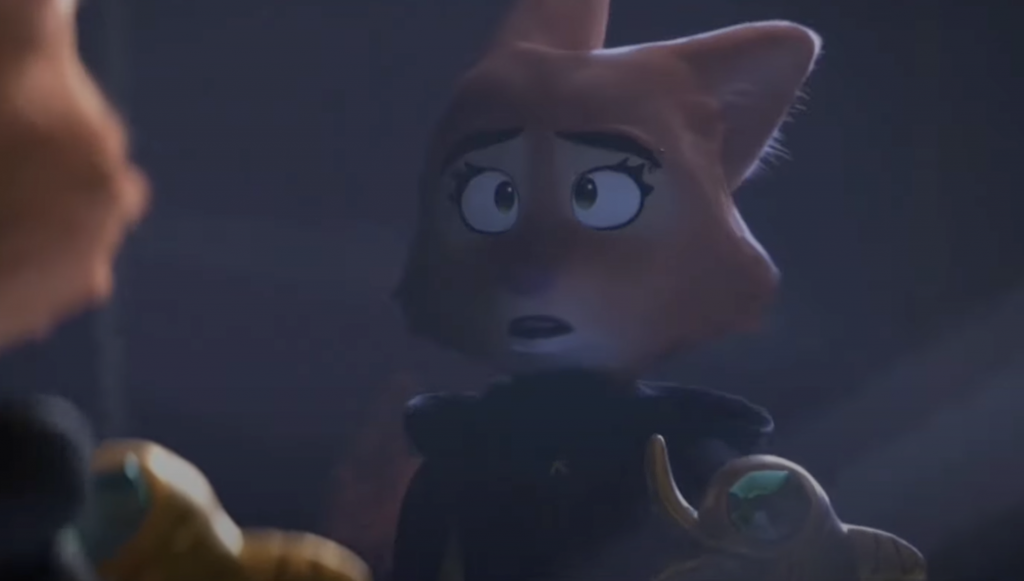
This moment encapsulates the moment Diane realised she wants to change. When seizing the Golden Dolphin, she has a sly, determined expression, being a stereotypical fictional characterisation of a fox. However, upon noticing her reflection, she realises she wants more out of her life than being a thief. Diane’s narration over this reveals this moment “changed everything”. She sheds the ninja-like mask she wears as the Crimson Paw, revealing her ‘true self’ during the heist. At this point, Diane realises she does not want to be remembered for what society brands her as, which provokes her to pursue a career as a governor.
Like Wolf, Diane is still a victim of the human-centric world of The Bad Guys, and while she admits the core moral of the story is true (that doing good things will bring you happiness), it is at the cost of her identity as a ‘tricky fox’. Despite giving up her thief persona, Diane still takes pride in being The Crimson Paw, being excited to return to her old ways to help Wolf; this can be interpreted as her ‘animal side’, since the face she presents to the public is that of an organised governor. She only feels comfortable revealing her alter-ego to a fellow animal, as she knows how the humans would react if she showed them this other side of herself. Unlike Wolf, Diane understands the importance of up-keeping a professional public image; where the former believes the world is against him simply for being born a wolf, Diane understands the humans are easily manipulated, and that change is not impossible.
The ‘Good Guys’ VS. The ‘Bad Guys’ — How Animal Representation and Stereotypes are used for Effective Storytelling
Professor Marmalade is a typical villain for a heist story — an unassuming, do-gooder who actually turns out to be an evil, money hungry mastermind. This idea is supported by his unassuming design as a guinea pig, an animal frequently mocked for being weak and harmless throughout the film. One instance of this is Snake’s frequent interest in eating guinea pigs because of their ‘goodheartedness’. The animal is also a very non-threatening pet to humans, so how could they possibly be evil? The scene above captures the essence of the film’s message, that judging a person (or anthropomorphic animal in this case) for their appearance is dangerous and ignorant. Marmalade knows how to manipulate the humans in this world like Diane, but he uses his philanthropic acts and cute face to gain power within the world of The Bad Guys. Although this characterisation is quite basic, the film uses the established world building to make him a threat to Wolf and his gang. All the main anthropomorphic characters are aware how society views them, as Marmalade summarises in this scene, “The Big Bad Wolf got outsmarted by a little piggy”, alluding back to Wolf’s speech at the beginning of the film, “You’re afraid, because I’m the Big Bad Wolf.” The film makes frequent references to fairy tales in which wolves are seen as a threat, since as noted before, this is how the humans in this world view The Bad Guys.
Wolf’s conflict throughout the film lies in his desire to be better, but when faced with the inverse of his character (a ‘good guy’ who is actually evil), he knows he cannot escape how he is portrayed by the humans. This leads to the pivotal moment when he lashes out at Marmalade:
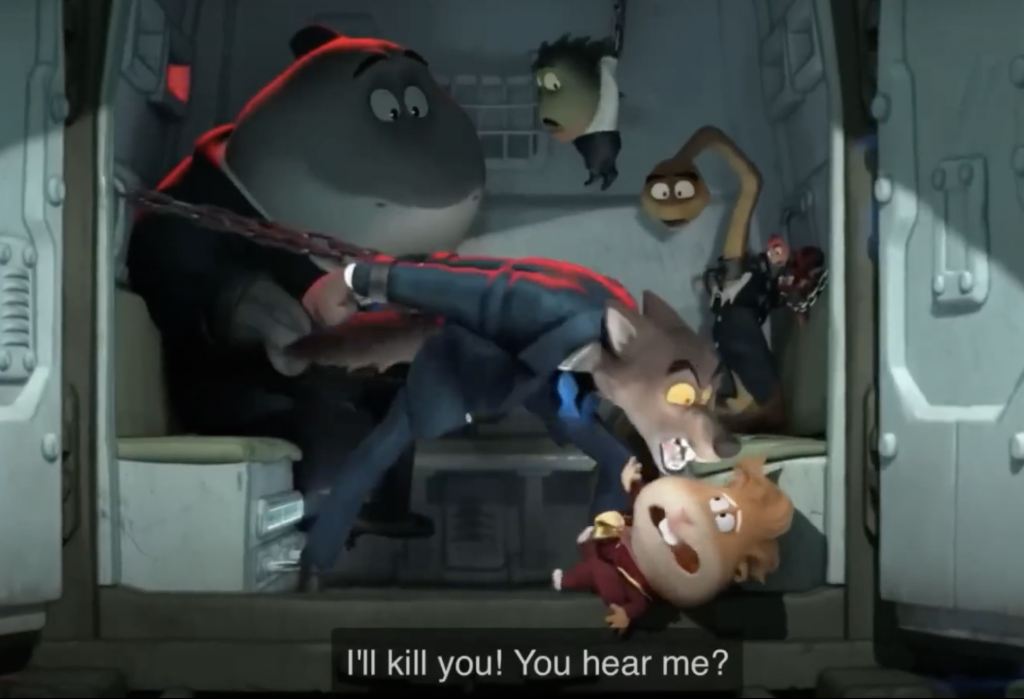
The frame here is fully focused on Wolf and Marmalade, the former taking up the centre of the shot. Wolf’s body is angular and looming, creating a frightening image of a more powerful animal threatening a harmless, cute pet. Wolf’s eyes are wide, and most importantly, his teeth are bared. Even when faced with the police, Wolf has never snarled at another character in the film up to this point, making his anger at Marmalade even more terrifying. Marmalade himself leans back to accommodate Wolf’s stance with a fearful expression, creating a scene suggesting a predator hunting its prey. The doors of the police truck are wide open, revealing Wolf’s ‘true’ character to the public, whilst his gang look on in confusion.
The Bad Guys themselves are treated as a collective, as due to Wolf’s actions in this scene, they are all thrown into prison. Unlike Diane or Marmalade, they are not granted a platform in which they can improve themselves and be seen as a ‘good’ animal. Even down to their names, the gang are only referred to as their species rather than having a ‘human’ name such as Diane, or a title like Professor Marmalade. Although by the end of the film (as typical of a children’s film), Marmalade is punished for his actions, the stereotypes forced upon The Bad Guys still land them in prison for a year — they aren’t the heroes in-universe, but they are satisfied with their own self improvement. The message of the film becomes a hopeful one, as the gang accept they can change for the better, and set out to change how the humans view them.
Overall, the film combines these themes in order to establish a positive message about self improvement for children. The animals in The Bad Guys are given human characteristics and motivations to create a relatable story; the animal characteristics given to each character are portrayed to be an in-world equivalent to a stereotype and/or myth. The anthropomorphic animals simply want to be accepted by the human society in order to escape stigmatisation for their species.
Bibliography
Duncan, Matt, ‘Consumerism, Aristotle and Fantastic Mr Fox’ , Film-Philsosophy 19 (2015)
Fantastic Mr Fox (2009) Directed by Anderson, Wes, 20th Century Fox, Accessed via Netflix
The Bad Guys (2022) Directed by Perifel, Pierre, Universal Pictures, Accessed via DVD
Wells, Paul, The Animated Bestiary: Animals, Cartoons, and Culture (New Brunswick, NJ: Rutgers University Press, 2008)
